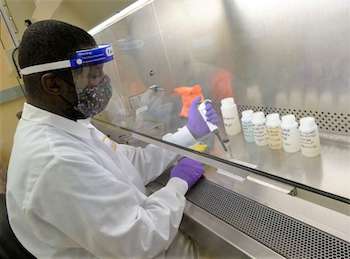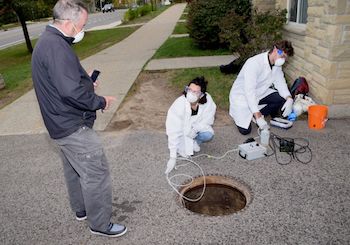Researchers at the University of Guelph are developing a wastewater testing methodology to detect levels of the SARS-CoV-2 virus and help prevent outbreaks of COVID-19 on university campuses.
Professor Lawrence Goodridge, who is leading the project, said a positive test in wastewater does not necessarily mean there is an active infection in the population.
The virus is shed in wastewater before a person shows symptoms and also potentially after a person has recovered, he said. Previous research has found the virus appears in wastewater roughly a week before it shows up in a population, said Goodridge.
In this case, the researchers are testing for elevated amounts of the virus in wastewater. The research is being supported by a number of University of Guelph researchers including Professor Ed McBean, Andrew Papadopoulos, and Heather Murphy. External partners in the study include Professor Roger C. Levesque at Laval University and Dr. Chrystal Landgraff of the Public Health Agency of Canada’s National Microbiology Laboratory.
“The University is being proactive,” said Goodridge. “If we find evidence of the virus in wastewater, it’s an indication that there is potentially a problem coming up. With that information, we can then take steps to take early action against that potential problem.”

Goodridge received funding from the University of Guelph in the early stages of the pandemic and used it to develop wastewater testing processes for measuring community level exposure to the virus.
“Our researchers bring their phenomenal knowledge and skills to bear to make a difference,” said Malcolm Campbell, vice president of research at the University of Guelph. “That’s why we knew it was essential to fund research like this when the pandemic hit. As we continue to grapple with the challenges of this pandemic, it is comforting to know that U of G innovation will be a vital tool in keeping not only our campus safe, but potentially our broader community as well.”
The project has progressed to the point where the research team is now gathering wastewater samples from a number of U of G residences.
“The data collected will have an immediate practical application because we can isolate the source of the infection by target testing in that area,” said Goodridge. “We appear to be the first in Canada to test a campus residence and use the data to try to make the campus safer.”

A wastewater sample, accumulated over the duration of a day, will provide reliable evidence of the amount of virus coming from a specific area where wastewater facilities are shared by a group of students, according to McBean. From samples, taken throughout the week, it is possible to determine if a resurgence of cases is happening.
In the event of elevated levels of the virus, the information could be used to reinforce practices that have proven effective in controlling the spread of COVID-19, including physical distancing, mask wearing, and handwashing. Additionally, testing could be carried out on that grouping of students, and those that test positive could then be isolated.
If used more widely, the process could help alleviate some of the pressure on COVID-19 testing centres by identifying schools or neighbourhoods where the virus is present and targeting individual testing more efficiently, according to McBean who is a former Senior Canada Research Chair in Water Supply Security.
“This could work anywhere where we can access sewage effluent,” said Goodridge, adding that wastewater testing for the virus is happening in other places around the world.
The research will also shed light on issues that remain uncertain related to testing for the virus in wastewater, Goodridge added, including what is the best type and volume of sample to take.
“I’m thrilled that U of G has considerable wastewater expertise,” said Goodridge. “This project would not have come about without that. Wastewater surveillance is here to stay. There are food-borne pathogens, emerging pathogens and there will probably be another coronavirus so we are working to get out in front of this.”
Header Image Credit: CDC.









